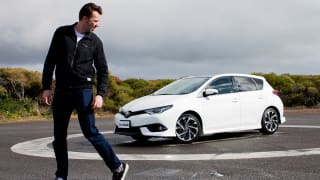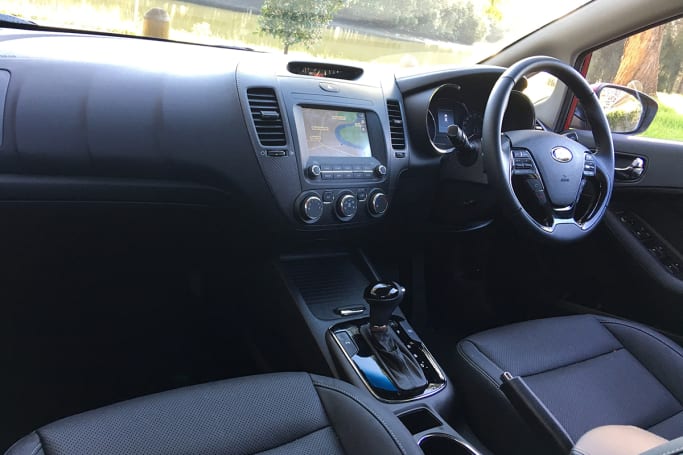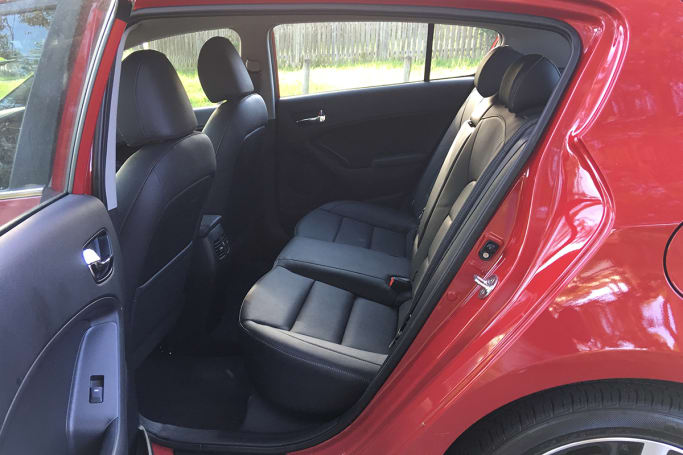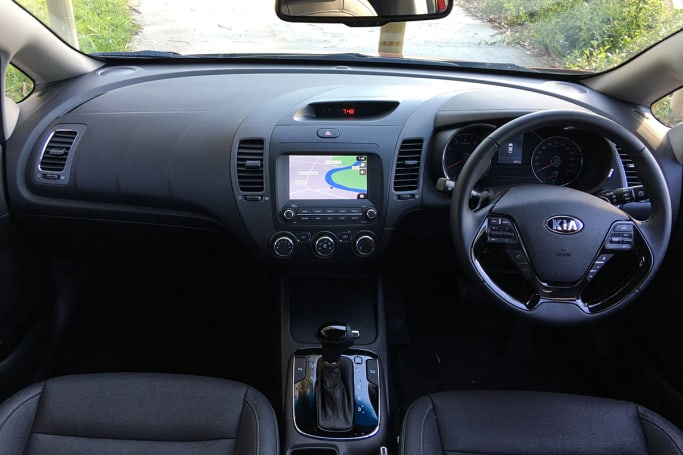
Toyota Corolla 2017 review
The Toyota Corolla. A small car that's been part of our local landscape since 1967. Not many cars can come close to making a claim like that. So how does the latest incarnation shape up?
Browse over 9,000 car reviews
Shakespeare was at least half-right when he posited that the clothes maketh the man, because they go a hell of a long way to making the Kia Cerato, too.
You can’t be too harsh on old Bill for not name-checking Kia's small car; the booming Korean brand was still some way off when he called it a night back in 1616. But there is no doubting that a fair chunk of the Cerato's success is thanks to the way it looks.
The cut-price Korean punches miles above its weight in the fashion stakes, cutting a fine and striking figure on the road - and one that defies its comparatively small price tag. Which is at least partly why it’s Kia’s best-selling model, defying the SUV-mania that has Australia in its grip to shift a whopping 15,977 units up to November this year (its closest rival in the Kia stable, the Sportage, has moved 11,606 cars over the same period).
But is it just the fancy suit that draws buyers to the Cerato? Or is there substance to match the style?
| Kia Cerato 2018: S (AV) | |
|---|---|
| Safety rating | |
| Engine Type | 2.0L |
| Fuel Type | Regular Unleaded Petrol |
| Fuel Efficiency | 7.1L/100km |
| Seating | 5 seats |
| Price from | $14,850 |
Much has been made of Kia’s design renaissance, and we won’t stomp those tired grounds again. Let us instead point out the bleeding obvious; the Cerato looks good. Damn good, in fact, with its European-flavoured body styling, mesh-grilled front end and swept-back headlights.
And the good news is that you won’t pay a style penalty (or at least, not a huge one) in opting for the cheapest Cerato, with even the S arriving with alloy-aping steel wheels, body skirting and colour-matching mirrors and bumpers. You can forget a big and looming body kit, wing or rear spoiler, even on the Sport and Sport+ models - understated charm is the order of the day here.
There are LED rear taillights, and the addition of daytime running lights makes the front-end just that tiny bit more premium. All in all, it’s a sharp-looking package.
If you want a non-metallic white car, there’s no price penalty. But opting for any of the other colours - 'Snow White Pearl', 'Aurora Black', 'Silky Silver', 'Metal Stream' (think grey), 'Temptation Red', 'Planet Blue' or 'Gravity Blue' (which is much darker) - will add $520 to the asking price.
As you can see from our interior photos, the cabin is a clean and simple space, with cloth or leather seats (depending on your budget), and soft-feel materials at most touch points if you spring for a more expensive model.

The biggest change inside as you step through the grades is the size of the screen: a pokey-looking letterbox vs a bigger, more modern-feeing touchscreen as you climb the ranks, with the latter both Apple CarPlay and Android Auto equipped. It’s the most obvious change in the Cerato model comparison.

At 4350mm long and 1450mm high (the sedan version is 4560mm long and 1435mm high) the Cerato’s relatively diminutive dimensions provide plenty of space for upfront riders, and the window seats in the back serve up ample room for adult passengers.
Up front, there are two cupholders, along with room in the doors for bottles. The small-size central storage bin is home to two power points and a USB source, and there’s a second, surprisingly deep storage bin that separates the two front seats. There’s a sunglass holder that’s integrated into the roof, too, as well as mirrors in each of the sun visors.
Climb into the back, and there’s plenty of room on offer, with good space between my knees and my own 5ft 8 inch driving position, and enough head room to sit comfortably, too. What else you find, though, depends on your budget. The cheaper cars have two cupholders and bottle storage in the doors, but zero in the way of creature comforts in the back. But the most expensive version does add air vents.
Seats up, the hatch models offer 385 litres (VDA) of really useable boot space, while the sedan increases luggage capacity to 482 litres - but it’s harder to get to, owing to the tighter boot aperture. And there are two ISOFIX attachment points, one in each window seat in the back.
Kia also offers a heap of official accessories, like roof racks, special floor mats, bike carriers and roof pods, to help amp up the Cerato’s practicality. You can also get a towbar / ball, which will give the little Cerato an unbraked towing capacity of 610kg, and 1200kg braked.
How much is a Kia Cerato? Well, that's a little easier to work out now than before. Kia has just trimmed the Cerato range from five to three models for 2018, with each available in hatch or sedan body style. The price list now kicks off with the value-packed S ($19,990 manual, $22,290 automatic), before stepping up to the auto-only Sport (increasing the cost to $24,790) and Sport+ ($27,290).

The cheapest Cerato sits on 16-inch steel wheels, and features heated wing mirrors and keyless entry. Inside, you’ll find cloth seats, manual air conditioning, power windows front and rear and cruise control.
Cabin technology is limited, though, with an MP3-compatible radio and CD Player displayed through a letterbox-style screen and that pairs with six speakers. You also get Bluetooth and steering-wheel controls.
Step up to the Sport and your standard specifications improve considerably. For one, you’ll find an Apple CarPlay and Android Auto-equipped seven-inch touchscreen as well as a standard navigation system (or you can use your mobile’s GPS for sat nav thanks to the phone integration) pairing with a six-speaker sound system. You’ll now find 17-inch alloy wheels, too, as well as a better steering wheel and a leather-wrapped instrument cluster and soft-touch door panels.

Finally, the Sport+ adds carbonfibre-effect trim inserts, a cooling glovebox and illuminated mirrors in the visors. The biggest change though is the leather (appointed) seats, and you also get gear-shift paddles on the steering wheel and vents for backseat passengers. Oh, and you get Kia’s smart key, unlocking a push-button start function. The cabin tech is the same, though, with an identical seven-inch screen controlling the multimedia system. You can forget a DVD player - this ain’t a Rolls.
Kia simplifies the engine specs with just the one motor on offer, right across the Cerato range. And that’s a refreshingly powerful 2.0-litre, four-cylinder unit good for 112kW (150 horsepower) at 6200rpm and 192Nm at 4000rpm. It's petrol-powered, of course, with no diesel or LPG options on offer.
Those are good specs for a small car, and while it’s a slightly old-school feeling unit, it’s engine size means it’s plenty punchy when it comes to jetting away from a traffic light, while the lack of a turbo ensures a constant flow of power without the infuriating lag.

In its cheapest guise, that power is channelled through a six-speed manual gearbox (though we’re yet to test it), or via a six-speed automatic transmission, and sent to the front wheels. There’s no 4x4 or AWD options, but with 140mm ground clearance, you surely weren’t expecting life-changing off-road performance.
Kia doesn’t quote official acceleration or 0-100km/h figures, but it’s a strong-feeling setup that’s perfectly suited to the Cerato.
The happy answer to the timing belt or chain question is that the Cerato uses a lower-maintenance chain. For other maintenance questions, like oil type, battery and gearbox maintenance, and at what mileage, consult the owners manual.
In sedan guise, the manual-equipped Cerato sips a claimed 7.3 litres per hundred kilometres on the combined cycle, and a microscopically better 7.2L/100km in automatic-equipped cars. Emissions are pegged at 168g/km of C02, no matter which gearbox you choose.
Opt for the hatch, and the claimed economy is 7.2 litres per 100 kilometres in both manual and automatic guise, and it will emit an identical 168g/km of C02.
Both the Cerato hatch and sedan will accept cheaper regular unleaded.
To be fair, on our test of the Cerato Hatch in Sport+ guise, the trip computer had our fuel consumption at a less-impressive 11.9 litres per hundred kilometres.
Both the Cerato hatch and sedan offer a 50-litre fuel-tank capacity, and will accept cheaper regular unleaded.
We’ve waxed lyrical about the quality of the ride in the Cerato range, but that was after an extensive test of the sedan. This time, though, we opted for the Sport+ hatch, and while it does feel slightly less supple, and very rough roads can find the outer limits of the (McPherson front, torsion rear) suspension, we’re happy to report there’s still an impressive blend of comfort and dynamics on offer that makes the Cerato feel far more composed (and expensive) than you might expect.

But first, that naturally aspirated 2.0-litre engine. There’s nothing in the way of fancy turbocharging or supercharging, but the simple delivery of power perfectly suits the nature of the Cerato. There’s plenty of speed off the line, and it never, ever feels underpowered.
The only downside is that when you do plant your foot, you’ll find there is a bit of rough harshness to the engine, and there is absolutely no exhaust note to speak of - it’s the engine noise or nothing. And the more gas you feed on, the louder the engine gets in the cabin, but then, you can’t win them all at this price point.
The steering is bang-on for what will likely be asked of the Cerato. It's light and easy, there’s almost no dead-air on centre, and it feels confidence-inspiringly direct without being sportscar skittish. The gearbox, when you’re smooth with it, is really intuitive, too, but it does have a tendency to jump down cogs with even the lightest accelerator pressure.
The vision out of the front is great, with little clear gaps that sit between the A-pillar and the windscreen to give you extra sightlines.
You're best to stay away from Sport mode, though, which seems to lock the gearbox into a too-low gear, adding noise without adding extra speed, while Eco mode doesn’t seem to do much of anything.
Basic Warranty
7 years / unlimited km warranty
ANCAP Safety Rating

Every Cerato, hatch or sedan, arrives with six airbags (dual front, front-side and curtain) and the normal suite of traction and braking aids like ABS and ESP. You’ll also find parking sensors front and rear, fog lights front and rear and Kia’s own Vehicle Stability Management system.
The keen-eyed among you might have noticed there is no reverse camera on that list. It is only standard from the Sport and Sport+ trim levels, and things like lane-keep assist, lane-departure warning and AEB don’t appear anywhere in the range.
The Kia Cerato scored the maximum five-star ANCAP safety rating when crash tested in 2014.
Seven years. Not just how long Brad Pitt spent in Tibet, but the staggering length of Kia’s unlimited-kilometre factory warranty. Think about that for a second: a Cerato you purchase in 2018 will still be under warranty in 2025. That’s great news for resale value.
Service intervals are pegged at 12 months or 15,000kms, and the brand’s capped-price servicing schedule will see your service costs run to $2479 over the first seven years of ownership - an average of $354 each year.
Kia’s are generally known for their reliability, but for any reported Kia Cerato issues, faults or common problems - including engine problems or gearbox, automatic transmission, clutch or suspension complaints - see our dedicated owner problems page.
You don't need to be more than the sum of your parts when all your parts work together quite so well as they do in the Cerato. A cheap(ish) car that doesn't look - or drive - like one, it's little wonder the Cerato is as popular as it is in the Kia range.
For our money, the best buying is at the entry or mid-point in the range, where you'll share the same engine and much the same look as the more expensive models.
| Vehicle | Specs | Price* | |
|---|---|---|---|
| S | 2.0L, ULP, 6 SP MAN | $13,750 – 18,040 | 2018 Kia Cerato 2018 S Pricing and Specs |
| S (AV) | 2.0L, ULP, 6 SP AUTO | $14,850 – 19,580 | 2018 Kia Cerato 2018 S (AV) Pricing and Specs |
| Koup Turbo | 1.6L, ULP, 6 SP MAN | No recent listings | 2018 Kia Cerato 2018 Koup Turbo Pricing and Specs |
| Sport | 2.0L, ULP, 6 SP AUTO | $17,710 – 22,440 | 2018 Kia Cerato 2018 Sport Pricing and Specs |
| Design | 8 |
|---|---|
| Practicality | 7 |
| Price and features | 8 |
| Under the bonnet | 7 |
| Efficiency | 7 |
| Driving | 8 |
| Safety | 7 |
| Ownership | 9 |
$10,951
Lowest price, based on 278 car listings in the last 6 months